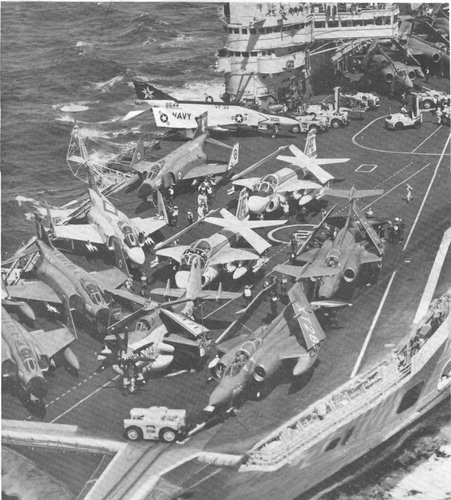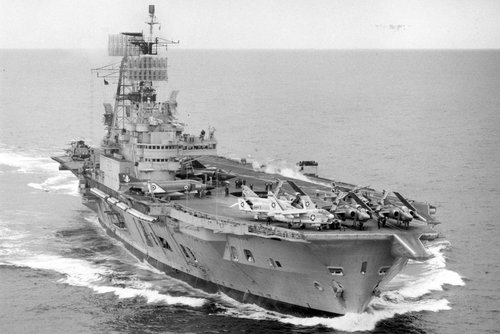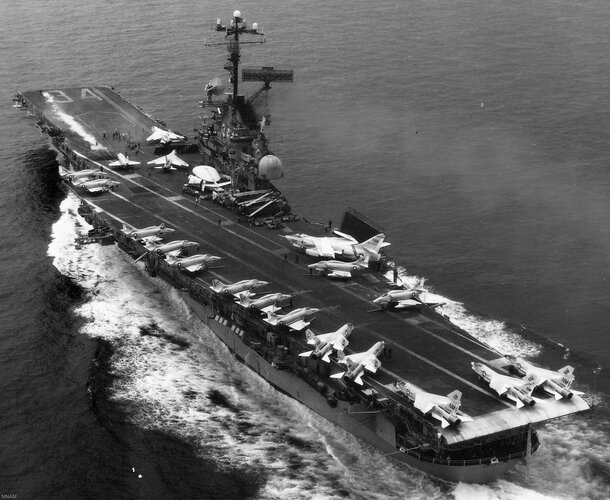- Joined
- 2 January 2006
- Messages
- 657
- Reaction score
- 261
As part of the Ship Group Build on the What-If Modeling forum i am attempting to build a 1/700 Essex Class that was proposed as a replacement for HMAS Melbourne based on the thread Abraham Gruber posted on here.
Build wise i am using the Trumpeter Essex class kit that depicts the WW2 original format of the ship and using a scaled drawing of the USS Oriskany as a basis for the modernisation.
The modelling of the ship has raised a few questions, as this envisaged a 1965 refit of an existing unmodified Essex rather one of the currently modified ships of the time, so this limits it to one of the designated Aircraft Transports or one of the LPH ships (the war damaged ones being excluded - Franklin & Bunker Hill). So given the later date what revisions would the US do to the Oriskany design to improve performance.
The 1964 date still has the F-4B Phantom as the aircraft of choice as at this time the USN hadn't disclosed that the F-4B wasn't suitable for smaller fleet carrier operations, so would they use the British inspired F-4K with the spey engines and extended leg, or would the F-4HL variant be built which coupled the K mods with a revised wing to give higher lift and a safer margin for smaller carrier operations ?
The other question regards weapons and sensor fit as at this time most of the RAN weaponry mirrored the RN, light AA being based on 40mm Bofors and SAM using the Sea Cat system. I suspect Seacat would have replaced the 5" guns and bofors with the Dutch search radar as fitted to the Melbourne as found in the 1965 edition of Janes that Melbourne would be modernised with Seacat (it wasn't much like Ark Royal wasn't ) but in 1964 the weapon was still in vogue.
I did find this interesting snippet on Wiki "An unmodernised Essex was offered to the Royal Australian Navy in 1960 as a replacement for HMAS Melbourne but the offer was declined due to the expense of modifications required to make it operationally compatible with the RAN's primarily British-designed fleet.[18]" which references Frame, Tom (1992). Pacific Partners: a history of Australian-American naval relations. p. 101..
So i suspect i am on the right track

Geoff
Build wise i am using the Trumpeter Essex class kit that depicts the WW2 original format of the ship and using a scaled drawing of the USS Oriskany as a basis for the modernisation.
The modelling of the ship has raised a few questions, as this envisaged a 1965 refit of an existing unmodified Essex rather one of the currently modified ships of the time, so this limits it to one of the designated Aircraft Transports or one of the LPH ships (the war damaged ones being excluded - Franklin & Bunker Hill). So given the later date what revisions would the US do to the Oriskany design to improve performance.
The 1964 date still has the F-4B Phantom as the aircraft of choice as at this time the USN hadn't disclosed that the F-4B wasn't suitable for smaller fleet carrier operations, so would they use the British inspired F-4K with the spey engines and extended leg, or would the F-4HL variant be built which coupled the K mods with a revised wing to give higher lift and a safer margin for smaller carrier operations ?
The other question regards weapons and sensor fit as at this time most of the RAN weaponry mirrored the RN, light AA being based on 40mm Bofors and SAM using the Sea Cat system. I suspect Seacat would have replaced the 5" guns and bofors with the Dutch search radar as fitted to the Melbourne as found in the 1965 edition of Janes that Melbourne would be modernised with Seacat (it wasn't much like Ark Royal wasn't ) but in 1964 the weapon was still in vogue.
I did find this interesting snippet on Wiki "An unmodernised Essex was offered to the Royal Australian Navy in 1960 as a replacement for HMAS Melbourne but the offer was declined due to the expense of modifications required to make it operationally compatible with the RAN's primarily British-designed fleet.[18]" which references Frame, Tom (1992). Pacific Partners: a history of Australian-American naval relations. p. 101..
So i suspect i am on the right track

Geoff





